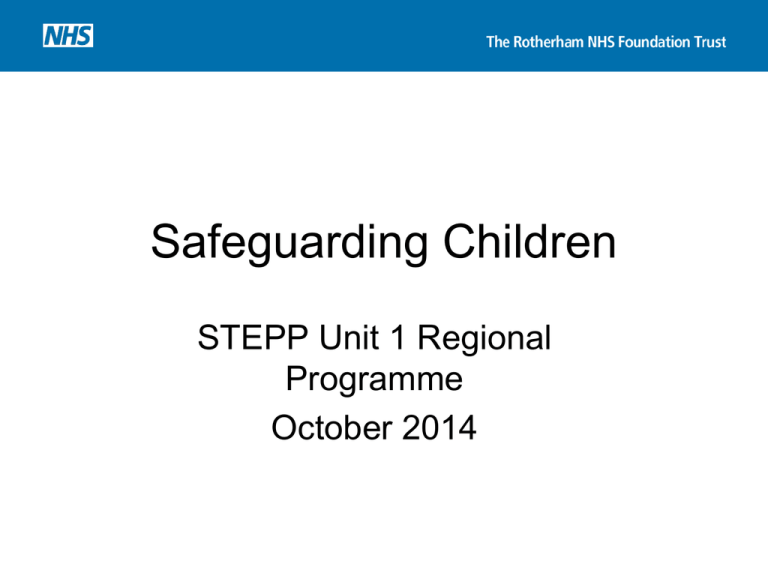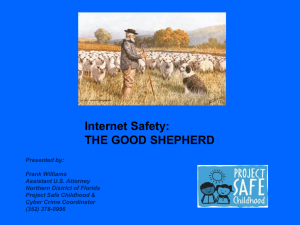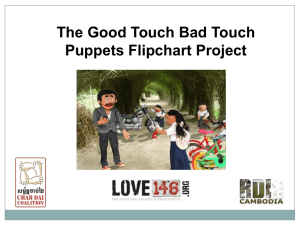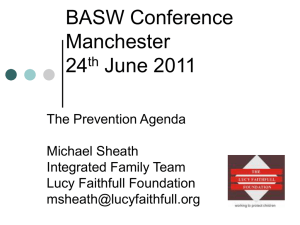
Safeguarding Children
STEPP Unit 1 Regional
Programme
October 2014
Objectives
• To be aware of the indicators of Abuse &
Neglect
• Understand the impact of family stressors on
the welfare of children
• To raise awareness of the importance of multi
agency working
• To gain basic understanding of the Legal
Framework in relation to Children
• The importance of listening to children
LEGAL FRAMEWORK
• The Framework for Assessment for Children
2000
• National Service Framework for
Children’s Services
2004
• Children Act
1989/2004
• Working Together
1999/2006/2013
• Rotherham Safeguarding Board Child Protection 2013
Procedures
‘SAFEGUARDING’,
• A duty to protect from maltreatment &
Impairment
• Ensuring children are growing up in
circumstances consistent with the provision of
safe and effective care that enables children
to have optimum life chances
[WTSC 2013]
CHILD PROTECTION
• Is part of safeguarding and promoting
welfare.
• Refers to the activity that is specifically
undertaken to protect specific children
who are suffering or at risk of suffering
significant harm as a result of abuse or
neglect.
[WTSC 2013]
CHILDREN IN NEED
• Children are defined as in need under the
Children Act 1989 [S17], as those whose
vulnerability is such that they are unlikely
to reach or maintain a satisfactory level of
health and development, or their health
and development will be significantly
impaired without the provision of services.
This will include disabled children.
SIGNIFICANT HARM
• The Children Act 1989 [S47] introduced
this concept as the threshold that
justifies compulsory intervention in
family life.
• Can be single or multiple events, which
interrupt, change or damage a child's
physical and psychological
development.
Indicators of Abuse & NeglectA Case Study
Scenario
• A 3 ½ year old attends the ED at 20:30
hours, with a swollen and painful left
arm.
• Mum states he fell from the settee
yesterday morning.
• He also had numerous other bruises.
• He appears pale and quiet.
• What are your thoughts?
• Do you have concerns?
• What next?
Gathering and sharing
information
•
•
•
•
•
•
•
•
•
D/W paeds/orthopods
Admit child
Child Protection medical
Health Visitor
GP
Social Care
Police
Nusery information
Strategy meeting…
Further information…
• Mum -significant domestic abuse with several
partners, (as victim and perpetrator) numerous police
attendances, weapons used, i.e. knives
• Maternal mental ill health-prev suicide attempts
• Parental alcohol misuse
• Several house moves
• Child thin, hungry and scavenging for food at school
• Other siblings previously presented with concerning
injuries
Child Protection Medical
• Spiral fracture left humerus
• Many bruises not explained by normal playtherefore unexplained
• Significantly malnourished
Discussion
Themes from Serious Case
Reviews
• Voice of the child not heard-not being spoken
to in their own language and alone
• Domestic abuse minimised by all agencies
• Alcohol misuse and mental health issues
unassessed by relevant professionals.
• Rule of Optimism prevailed, the significant
injury too readily accepted as accidental.
• Invisible men
• Balance of probabilities
• Resistant families –Disguised Compliance
Physical Abuse
Physical abuse may involve hitting, shaking,
throwing, poisoning, burning or scalding,
drowning, suffocating, or otherwise causing
physical harm to a child. Physical harm may
be caused when a parent or carer fabricates
the symptoms of, or deliberately induces
illness in a child.
Working Together to Safeguard Children DCFS 2013
Possible Indicators Physical
•
•
•
•
Bruises:
To the eyes, mouth or ears
Finger tip bruising (grasp marks)
Bruises of different ages in the same place
Outline bruises (prints of hands, belts, shoes
etc)
• Bruises without obvious and verifiable
explanations
• Bruises to non-mobile babies (consider the
possibility of shaking)
Possible Indicators (cont)
• Burns, bites and scars:
• Clear impressions of teeth (if more than 3cm
across, they are unlikely to have been made
by a child)
• Burns or scalds with clear outlines
• Small round burns which may be from
cigarettes
• Large numbers of different aged scars
• Unusually shaped scars
• Scars that indicate that the child did not
receive medical treatment
Possible Indicators (cont)
• Fractures
• Fractures in children under one year of age
• Allegedly unnoticed fractures
• Other injuries:
• Poisoning, injections, ingestion or other application of
dangerous substances (including drugs and alcohol)
• Female genital mutilation, including female
circumcision.
• Signs of shaking including: -any bruising to a young
baby – particularly the trunk/ arms/ face -facial
petechiae
Impact of Physical abuse
•
•
•
•
Neurological damage
Physical injuries
Disability
Death
Linked to:
•
•
•
Aggressive behavior
Emotional and behavioral difficulties
Educational difficulties
Historical Indicators
• History is incompatible with injury type
• History of how the injury occurred is vague
• History changes each time it is told to a
different health care worker
• Parents, when interviewed separately, give
contradictory histories
• History is not credible, actions are not age
appropriate
Behavioural Indicators
• There is often a significant delay between the time
of injury and the time of presentation
• The parent may not show the degree of concern
appropriate to the severity of the child’s injury
• A pathological parent/child interaction is observed.
• Unrealistic expectations, inappropriate demands,
angry impulsive behaviour
Sexual Abuse
Sexual abuse involves forcing or enticing a child or young person to
take part in sexual activities, not necessarily involving a high level of
violence whether or not the child is aware what is happening. The
activities may involve physical contact including assault by penetration
(for example, rape, or oral sex) or non-penetrative acts such as
masturbation, kissing, rubbing and touching outside of clothing. They
may also include non-contact activities, such as involving children in
looking at, or in the production of sexual images, watching sexual
activities, or encouraging children to behave in sexually inappropriate
ways, or grooming a child in preparation for abuse ( including via the
internet). Sexual abuse is not solely perpetrated by adult males.
Women can also commit acts of sexual abuse, as can other children.
Working Together to Safeguard Children DCSF 2013
Possible Indicators Sexual
Abuse
Sexually-transmitted infections
Sexual play
Hidden/Unexplained pregnancy
Sexually explicit behaviour
Recurrent urinary infections
Sexual knowledge inappropriate to
Genital and rectal soreness
Unexplained bleeding and
discharges
the age of the child
Sexually abusive behaviour towards
other children, particularly those
Bruising in the genital region
younger or more vulnerable than
masturbation that is judged to be
inappropriate to a child’s age,
development and circumstances
themselves
NO INDICATION OR DISCLOSURE
Impact of Sexual Abuse
• Effects of pregnancy or sexually
transmitted infections
• Low self esteem
• Depression and suicide
• Coping with secrecy
• Educational and social difficulties
CSE
Child Sexual Exploitation
The sexual exploitation of children and young people (CSE) under-18 is defined as that
which:
‘involves exploitative situations, contexts and relationships where young people (or a third person
or persons) receive ‘something’ (e.g. food, accommodation, drugs, alcohol, cigarettes, affection,
gifts, money) as a result of them performing, and/or another or others performing on them, sexual
activities. Child sexual exploitation can occur through the use of technology without the child’s
immediate recognition; for example being persuaded to post sexual images on the Internet/mobile
phones without immediate payment or gain. In all cases, those exploiting the child/young person
have power over them by virtue of their age, gender, intellect, physical strength and/or economic
or other resources. Violence, coercion and intimidation are common, involvement in exploitative
relationships being characterised in the main by the child or young person’s limited availability of
choice resulting from their social/economic and/or emotional vulnerability’ (Department for Education
2012 )
Important aspects to consider
Sexual exploitation occurs in a social context of violence towards
women. However boys and young men can be exploited too.
Abusers coercers often physically, emotionally and sexually abuse
children and young people and I some cases may imprison
them.
Because of either their age or their needs, children and young
people are unable to give truly informed consent to relationships
and sexual activity
Children and young people do not make informed choices to enter
or remain in sexually exploitation but do so due to coercion,
enticement manipulation of desperation
Young people under the age of 16 cannot legally give consent to
sexual activity
Sexual intercourse with a child under the age of 13 is statutory rape
Potential Indicators of Sexual Exploitation
•
•
•
•
•
•
•
•
•
•
•
Unaccountable gifts/monies
Experimenting with drugs and alcohol
Reduced contact with family and friends
Changes in behaviour/friendship groups
Coming home late/going missing
Older boyfriend
STI's repeat attendances at sexual health services
Internet grooming
Getting into cars with unknown males
Sexual activity at an early age
Unexplained injuries
Factors heightening the risk of
CSE
•
•
•
•
•
•
•
Children in Care
Early CP concerns
Previous sexual abuse
Family bereavement
Family alcohol use
Substance misuse
Poor school attendance
• Peers being exploited
•
•
•
•
•
•
•
•
•
Homelessness
Domestic violence
Previous abuse
Dysfunctional family
Male domination
Poverty
Learning disabilities
Learning difficulties
Gang association
•
•
•
•
•
Enforcing the CSE
Gifts- drugs/alcohol
Promoting dependence on substances
Fear
Mobile top ups
False promises of physical and emotional
abuse
• Threats to family members
ALWAYS A POWER IMBALANCE,
PERPETRATORS ALWAYS HAVE CONTROL
OVER THEIR VICTIMS
Sexual Exploitation Team
Receive referrals from the CART Team
Based at PPU Maltby
Dedicated team who offer support is
Social Care Manager Claire Edgar
01709 832699
Qualified Social Workers
Parent Support Worker
Dedicated Police Officers
Link closely to health professionals
SARC
• A service where female and male victims of
rape and sexual assault can receive medical
care and counselling all under one roof.
• The service takes self-referrals or referrals
can be made through other services such as
the police.
• Telephone: 01709 307327
• The Isis, Rotherham NHS Foundation Trust,
Moorgate Road, Rotherham, S60 2UD.
Children's Independent Sexual
Violence Advisor (CISVA)
• Police bring children to centre for examination
following an allegation
• Referral is made to CISVA
• CISVA provides holistic support to the child and
their family to assist and guide them through any
legal processes and help them access relevant
support services
Neglect
Neglect is the persistent failure to meet a child’s basic physical and/or
psychological needs, likely to result in the serious impairment of the
child’s health or development. Neglect may occur during pregnancy as
a result of maternal substance abuse. Once a child is born, neglect
may involve a parent or carer failing to:
•
•
•
•
provide adequate food, clothing and shelter including exclusion from
home or abandonment.
protect a child from physical and emotional danger;
ensure adequate supervision (including the use of inadequate care
givers); or
ensure access to appropriate medical care or treatment.
May also include neglect or unresponsiveness to a child’s basic
emotional needs.
Working Together to Safeguard Children DCSF 2013
Possible Indicators Neglect
• Children who are:
• Not receiving adequate food, emotional
warmth, supervision or stimulation.
• Exposed to inadequate, dirty / cold
environments
• Prevented by their carers from receiving
appropriate medical advice or treatment
Impact of Neglect
•
•
•
Impairment of growth
Impairment of intellectual development
Death
Long-term difficulties with :
•
•
•
Social functioning
Relationships
Educational progress.
EMOTIONAL ABUSE
The persistent ill-treatment of a child such as to cause
severe and persistent adverse effects on the child’s
emotional development. It may involve conveying to
children they are worthless, unloved in adequate or
valued only insofar as they meet the needs of another
person. It may include not giving the child opportunities
to express their views, deliberately silencing them or
‘making fun’ of what they say or how they communicate.
It may feature age or developmentally inappropriate
expectations being placed on children.
Working Together to Safeguard Children DCSF 2013
Emotional Abuse Cont
These may include interactions that are beyond the child’s
developmental capacity, as well as overprotection and
limitation of exploration and learning, or preventing the child
participating in normal social action.
It may involve seeing or hearing the ill treatment of
another. it may involve serious bullying (including cyber
bullying) causing children frequently to frightened or in
danger, or the exploitation or corruption of children. Some
level of emotional abuse is involved in all types of
maltreatment of a child, though it may occur alone.
Working Together to Safeguard Children DCSF 2013
Possible Indicators Emotional
Abuse
• Abnormally passive, lethargic, withdrawn or attentionseeking behaviour
• Specific habit disorders, e.g. faecal smearing, excessive
drinking, eating unusual substances and self harm
• Severely delayed social development, poor language
and speech development not otherwise explained
• Excessively nervous behaviour such as rocking or hair
twisting
• Low self esteem
Impact of Emotional Abuse
- Long-term
consequences for
children's
development
- Impacts on a
developing child's
mental health,
behavior and selfesteem.
- It can be especially
damaging in infancy.
CONSENT/CONFIDENTIALITY
Best practice to inform parents/carers what your
concerns are and that a referral to social care is to
be made
UNLESS
You will impair a criminal investigation
Suspect fabricated or induced Illness
Suspect sexual abuse
You are concerned for the child’s or your own safety
Consent not necessary to share information if
the child is at risk of significant harm.
Factors influencing parenting
capacity
• Mental Health Problems
• Substance Misuse
• Domestic Abuse
• Learning Difficulties
• Family and Environmental Factors
• Racism
Parental mental health issues
• One in four adults will experience a mental illness in
their lifetime.
• Of these, between a quarter and a half will be parents.
• Their dependent children are at greater risk of
experiencing health, social and/or psychological
problems.
• Combined issues such as genetic inheritance, social
adversity and psychological factors may lead to an
increased chance of children experiencing mental
health issues.
Parental mental health issues
• The impact of mental ill health on parental capacity
will depend on the parent’s personality, the type of
mental illness, its severity, the treatment given and
support provided.
• Many mental health problems are manifested in
intermittent episodes of symptoms.
• This can result in fluctuations between good and poor
parental capacity.
Parental Substance Misuse
• Research carried out to inform the Advisory Council
on the Misuse of Drugs report, ‘Hidden Harm’ (2003),
estimated:
– 200,000-300,000 children of problem drug users in England
and Wales
– this represents 2-3% of children less than 16 years.
• Between 780,000 and 1.3 million children are
affected by parental alcohol use in England and
Wales (Harwin et al. 2009).
Parental Substance Misuse
Parents report effects on:
–
–
–
–
providing a daily structure.
being consistent.
managing their children’s anger.
coping with children’s transition into adolescence,
especially if it involves experimentation with drugs.
– generally perceiving difficulties rather than positives in
child’s behaviour.
(Coleman and Cassell, 1995)
Domestic abuse
•
26% children and young people report physical violence in
childhood:
–
47% physical assaults
–
13% used object or weapon
•
5% violence frequent.
•
£23 billion per annum (England and Wales).
•
More than 90% of domestic abuse is committed by men
against women.
•
Approximately 10% to 50% of women have been physically
abused by an intimate male partner.
•
UK statistics indicate that one in four women is likely to suffer
domestic abuse.
Domestic abuse
The impact on parental capacity can manifest in:
•
•
•
•
•
lack of emotional warmth
emotional unavailability
inconsistent or unpredictable care environment
pre-occupation with the intimate relationship
increased levels of irritability, hostility, rejection and
aggression
• increased risk of parental mental ill-health and
substance misuse
• physical exhaustion and low self-esteem
• increased likelihood of anxiety and social exclusion.
MARAC
• Multi Agency Risk Assessment
Conference
• Multi agency approach to support
victims of domestic violence
• Previously 18yrs+
• Now National pilot scheme 16/17yrs
LEARNING DISABILITES
• Can be wide ranging
• Accurate assessment of effects and impact
upon parenting capacity essential
• Family/ professional support?
• Use of accessible, appropriate information
• Assessment of capacity should be considered
to ensure appropriate service provision
Racism
• Institutionalised
• Community Experiences
• Should be explicitly considered in
assessment process
• Lack of appropriate service provision
• Need for robust interpretation policy
Points to remember
• Beware of the Rule of Optimism
• Do not believe all you are told without
evidence
• Always consider motivation of parents
to change
• Consider family history of ability to
change
• Chronologies are useful
Record Keeping
• Be diligent in your record keeping
• Be clear and factual
• If sharing a professional opinion be
clear about this
• Record where you gained information
from - - who told you what and when
• Records should be contemporaneous
Questions










